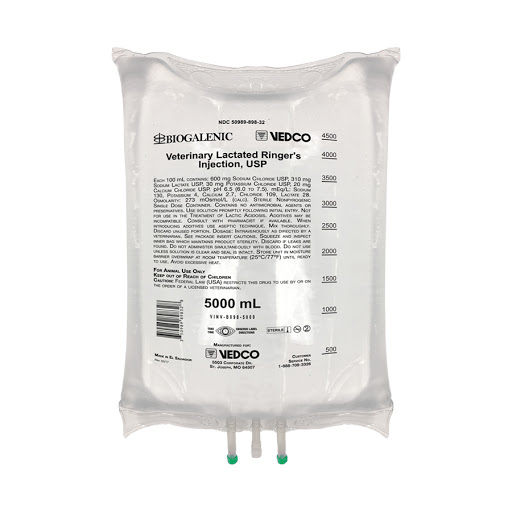Can Ringers Lactate be used in Diabetes (DKA)
By Prince Assandoh-Mensah in 2017
Diabetic Ketoacidosis (DKA) is caused by an absence or markedly inadequate amount of insulin. Patients suffering from this condition often have hyperglycemia (high blood sugar level), dehydration and electrolyte loss and acidosis. The goal of management of this condition is often to correct these three cardinal clinical features.
Fluid therapy is an integral part of DKA management and the choice of fluid is very critical to the resolution of patient’s symptoms. It must have the ability to control blood sugar, rehydrate and replace loss electrolytes (sodium and potassium) and correct acidosis (low blood pH).
Over the years, Normal Saline is often used in most clinical settings; coupled with other treatment regimen such as insulin and other antidiabetic agent. This is due to its (Normal Saline) ability to control high blood sugar level and replace blood sodium (Na+) level. However, it lacks the ability to restore other key electrolytes such as potassium and also correct acidosis. The high chloride Cl– content in Normal Saline also causes acidosis.
Ringers Lactate (R/L), since its introduction by Alexis Hartmann (1898 -1964), an American Pediatrician, has been one of the most widely used intravenous (IV) fluid in the clinical setting. It contains Sodium Chloride (in lesser amount than in N/S), Potassium Chloride, Calcium Chloride and Non-Cl anion Lactate to prevent metabolic acidosis.
Its use in DKA, though very effective, is more recent than Normal Saline. Aside being able to control blood sugar and rehydrate, it’s also able to contribute to restoring blood sodium (Na + ) and potassium (K +), and correct blood acidosis faster than Normal Saline.
Over the years Normal Saline has been preferred over Ringers Lactate in fear of acute hyperglycaemia. This was chiefly base on Thomas and Alberti (1975) findings which suggested that, the lactate in Ringers is converted to glucose (blood sugar) in the body and thus could contribute significantly to the body’s blood sugar level increase.
However more recent studies suggest that, Ringers Lactate does not significantly increase blood glucose concentration. Simpson et al (2008) argued that the 29 mmol/L of lactate from Hartmann’s solution (another name for Ringers Solution) could yield 14.5 mmol of glucose at most. While this number is clinically significant, after accounting for extracellular redistribution, this number is considerably reduced to approximately 1 mmol/L which is clinically insignificant.
Billiodeaux et al (2014) added that, this would at most, only result in a change of 1 degree of insulin sliding scale or basal rate adjustment and is therefore clinically insignificant.
Ringers Lactate is an alternate intravenous fluid for DKA. Though it has a relatively longer glucose normalisation time than Normal Saline, it possesses a shorter blood pH normalization time than NS. PLASMA-LYTE, a solution that contains an ionic concentration of 140 mEq sodium, 5 mEq potassium, 3 mEq magnesium, 98 mEq chloride, 27 mEq acetate, and 23 mEq gluconate per litre, has proved to be a better infusion of choice for DKA but it is also generally costly.
REFERENCE
Billiodeaux, S. T., Samuelson C. G., Fox C. G. (2014). Intraoperative and Postoperative Blood Glucose Concentrations in Diabetic Surgical Patients Receiving Lactated Ringer’s Versus Normal Saline: A Retrospective Review of Medical Records. The Ochsner Journal. Ochsner Clinic Foundation
Brandel, R. L. (2015). Ringer’s Lactate vs. Normal Saline in the pre-hospital protocols. Isotonic, hypertonic, hypotonic fluids, when, why, and where are they primarily used? NREMT Rappahannock Community College, Fall 2015, EMS 209 – Advanced Pharmacology
Daksha, J. (2013). Comparison of the use of normal saline versus Ringer`s lactate in the fluid resuscitation of diabetic ketoacidosis. URI: http://hdl.handle.net/10539/12476
Hinkle, J. L. (2014). Brunner & Suddarth’s textbook of medical-surgical nursing (Edition 13.). Philadelphia: Wolters Kluwer Health/Lippincott Williams & Wilkins.
Rajamani, S., Selvarajan, K. P. & Radhakrishnan, S. (2017). A Comparative Study between Ringer Lactate, Normal Saline and Plasmalyte on the Serum Electrolytes of Patients with Diabetic Ketoacidosis. Indian Journal of Medical & Health Sciences. Volume 4, Issue 1, January – June 2017, Pages 23-29
Simpson AK, Levy N, Hall GM. Peri-operative i.v. fluids in diabetic patients—don’t forget the salt. Anaesthesia. 2008 Oct;63(10):1043–1045. [PubMed]
Thomas DJ, Alberti KG. Hyperglycaemic effects of Hartmann’s solution during surgery in patients with maturity onset diabetes. Br J Anaesth. 1978 Feb;50(2):185–188. [PubMed]
Walsh ES, Traynor C, Paterson JL, Hall GM. Effect of different intraoperative fluid regimens on circulating metabolites and insulin during abdominal surgery. Br J Anaesth. 1983 Feb;55(2):135–140. [PubMed] [Ref list]
Van Zyl, D. G., Rheeder. P., & Delport. E. (2012). Fluid management in diabetic-acidosis–Ringer’s lactate versus normal saline: a randomized controlled trial. QJM. 2012 Apr;105(4):337-43. doi: 10.1093/qjmed/hcr226. Epub 2011 Nov 22




